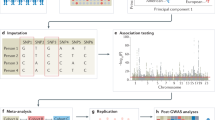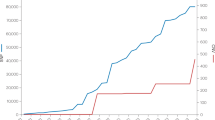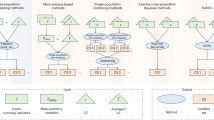Abstract
Identification of the genetic polymorphisms that contribute to susceptibility for common diseases such as type 2 diabetes and schizophrenia will aid in the development of diagnostics and therapeutics. Previous studies have focused on the technique of genetic linkage, but new technologies and experimental resources make whole-genome association studies more feasible. Association studies of this type have good prospects for dissecting the genetics of common disease, but they currently face a number of challenges, including problems with multiple testing and study design, definition of intermediate phenotypes and interaction between polymorphisms.
This is a preview of subscription content, access via your institution
Access options
Subscribe to this journal
Receive 51 print issues and online access
$199.00 per year
only $3.90 per issue
Buy this article
- Purchase on SpringerLink
- Instant access to full article PDF
Prices may be subject to local taxes which are calculated during checkout


Similar content being viewed by others
References
Botstein, D. & Risch, N. Discovering genotypes underlying human phenotypes: past successes for mendelian disease, future approaches for complex disease. Nature Genet. 33 (suppl.), 228–237 (2003).
Grody, W. W. et al. PCR-based screening for cystic fibrosis carrier mutations in an ethnically diverse pregnant population. Am. J. Hum. Genet. 60, 935–947 (1997).
Kosorok, M. R., Wei, W. H. & Farrell, P. M. The incidence of cystic fibrosis. Stat. Med. 15, 449–462 (1996).
Rocchi, A., Pellegrini, S., Siciliano, G. & Murri, L. Causative and susceptibility genes for Alzheimer's disease: a review. Brain Res. Bull. 61, 1–24 (2003).
Collins, F. S., Guyer, M. S. & Chakravarti, A. Variations on a theme: cataloging human DNA sequence variation. Science 278, 1580–1581 (1997).
Slooter, A. J. et al. Risk estimates of dementia by apolipoprotein E genotypes from a population-based incidence study: the Rotterdam Study. Arch. Neurol. 55, 964–968 (1998).
Risch, N. & Merikangas, K. The future of genetic studies of complex human diseases. Science 273, 1516–1517 (1996).
Lohmueller, K. E., Pearce, C. L., Pike, M., Lander, E. S. & Hirschhorn, J. N. Meta-analysis of genetic association studies supports a contribution of common variants to susceptibility to common disease. Nature Genet. 33, 177–182 (2003).
Reich, D. E. & Lander, E. S. On the allelic spectrum of human disease. Trends Genet. 17, 502–510 (2001).
Patil, N. et al. Blocks of limited haplotype diversity revealed by high-resolution scanning of human chromosome 21. Science 294, 1719–1723 (2001).
Sachidanandam, R. et al. A map of human genome sequence variation containing 1.42 million single nucleotide polymorphisms. Nature 409, 928–933 (2001).
Zondervan, K. T. & Cardon, L. R. The complex interplay among factors that influence allelic association. Nature Rev. Genet. 5, 89–100 (2004).
Kruglyak, L. Prospects for whole-genome linkage disequilibrium mapping of common disease genes. Nature Genet. 22, 139–144 (1999).
Zhang, K., Calabrese, P., Nordborg, M. & Sun, F. Haplotype block structure and its applications to association studies: power and study designs. Am. J. Hum. Genet. 71, 1386–1394 (2002).
Risch, N. & Teng, J. The relative power of family-based and case–control designs for linkage disequilibrium studies of complex human diseases I. DNA pooling. Genome Res. 8, 1273–1288 (1998).
Risch, N. Evolving methods in genetic epidemiology. II. Genetic linkage from an epidemiologic perspective. Epidemiol. Rev. 19, 24–32 (1997).
The International HapMap Consortium. The International HapMap Project. Nature 426, 789–796 (2003).
Carlson, C. S. et al. Selecting a maximally informative set of single-nucleotide polymorphisms for association analyses using linkage disequilibrium. Am. J. Hum. Genet. 74, 106–120 (2004).
Ke, X. & Cardon, L. R. Efficient selective screening of haplotype tag SNPs. Bioinformatics 19, 287–288 (2003).
Stram, D. O. et al. Choosing haplotype-tagging SNPS based on unphased genotype data using a preliminary sample of unrelated subjects with an example from the Multiethnic Cohort Study. Hum. Hered. 55, 27–36 (2003).
Weale, M. E. et al. Selection and evaluation of tagging SNPs in the neuronal-sodium-channel gene SCN1A: Implications for linkage-disequilibrium gene mapping. Am. J. Hum. Genet. 73, 551–565 (2003).
Johnson, G. C. et al. Haplotype tagging for the identification of common disease genes. Nature Genet. 29, 233–237 (2001).
Gabriel, S. B. et al. The structure of haplotype blocks in the human genome. Science 296, 2225–2229 (2002).
Collins, F. S., Green, E. D., Guttmacher, A. E. & Guyer, M. S. A vision for the future of genomics research. Nature 422, 835–847 (2003).
Devlin, B. & Risch, N. A comparison of linkage disequilibrium measures for fine-scale mapping. Genomics 29, 311–322 (1995).
Lander, E. & Kruglyak, L. Genetic dissection of complex traits: guidelines for interpreting and reporting linkage results. Nature Genet. 11, 241–247 (1995).
Sawcer, S. et al. Empirical genomewide significance levels established by whole genome simulations. Genet. Epidemiol. 14, 223–229 (1997).
A meta-analysis of whole genome linkage screens in multiple sclerosis. J. Neuroimmunol. 143, 39–46 (2003).
Collins, F. S., Brooks, L. D. & Chakravarti, A. A DNA polymorphism discovery resource for research on human genetic variation. Genome Res. 8, 1229–1231 (1998).
Halushka, M. K. et al. Patterns of single-nucleotide polymorphisms in candidate genes for blood-pressure homeostasis. Nature Genet. 22, 239–247 (1999).
Cargill, M. et al. Characterization of single-nucleotide polymorphisms in coding regions of human genes. Nature Genet. 22, 231–238 (1999).
Stephens, J. C. et al. Haplotype variation and linkage disequilibrium in 313 human genes. Science 293, 489–493 (2001).
Schwartz, S. et al. MultiPipMaker and supporting tools: Alignments and analysis of multiple genomic DNA sequences. Nucleic Acids Res. 31, 3518–3524 (2003).
Mayor, C. et al. VISTA: visualizing global DNA sequence alignments of arbitrary length. Bioinformatics 16, 1046–1047 (2000).
Boffelli, D. et al. Phylogenetic shadowing of primate sequences to find functional regions of the human genome. Science 299, 1391–1394 (2003).
Thomas, J. W. et al. Comparative analyses of multi-species sequences from targeted genomic regions. Nature 424, 788–793 (2003).
Bansal, A. et al. Association testing by DNA pooling: an effective initial screen. Proc. Natl Acad. Sci. USA 99, 16871–16874 (2002).
Mohlke, K. L. et al. High-throughput screening for evidence of association by using mass spectrometry genotyping on DNA pools. Proc. Natl Acad. Sci. USA 99, 16928–16933 (2002).
Howell, W. M., Evans, P. R., Wilson, P. J., Cawley, M. I. & Smith, J. L. HLA class II DR, DQ, and DP restriction fragment length polymorphisms in rheumatoid arthritis. Ann. Rheum. Dis. 48, 295–301 (1989).
Yang, Y. et al. Efficiency of single-nucleotide polymorphism haplotype estimation from pooled DNA. Proc. Natl Acad. Sci. USA 100, 7225–7230 (2003).
Permutt, M. A. et al. Searching for type 2 diabetes genes on chromosome 20. Diabetes 51 (suppl. 3), S308–S315 (2002).
Barcellos, L. F. & Thomson, G. Genetic analysis of multiple sclerosis in Europeans. J. Neuroimmunol. 143, 1–6 (2003).
Kammerer, S. et al. Amino acid variant in the kinase binding domain of dual-specific A kinase-anchoring protein 2: a disease susceptibility polymorphism. Proc. Natl Acad. Sci. USA 100, 4066–4071 (2003).
Sham, P., Bader, J. S., Craig, I., O'Donovan, M. & Owen, M. DNA pooling: A tool for large-scale association studies. Nature Rev. Genet. 3, 862–871 (2002).
Cristea, I. M., Gaskell, S. J. & Whetton, A. D. Proteomics techniques and their application to hematology. Blood 103, 3624–3634 (2004).
Haufroid, V. & Lison, D. Urinary cotinine as a tobacco-smoke exposure index: a minireview. Int. Arch. Occup. Environ. Health 71, 162–168 (1998).
Schork, N. J. Power calculations for genetic association studies using estimated probability distributions. Am. J. Hum. Genet. 70, 1480–1489 (2002).
Storey, J. D. & Tibshirani, R. Statistical significance for genomewide studies. Proc. Natl Acad. Sci. USA 100, 9440–9445 (2003).
Bolk, S. et al. A human model for multigenic inheritance: phenotypic expression in Hirschsprung disease requires both the RET gene and a new 9q31 locus. Proc. Natl Acad. Sci. USA 97, 268–273 (2000).
Zetterberg, H., Zafiropoulos, A., Spandidos, D. A., Rymo, L. & Blennow, K. Gene–gene interaction between fetal MTHFR 677C > T and transcobalamin 776C > G polymorphisms in human spontaneous abortion. Hum. Reprod. 18, 1948–1950 (2003).
Butt, C. et al. Combined carrier status of prothrombin 20210A and factor XIII-A Leu34 alleles as a strong risk factor for myocardial infarction: evidence of a gene–gene interaction. Blood 101, 3037–3041 (2003).
Tiret, L. et al. Synergistic effects of angiotensin-converting enzyme and angiotensin-II type 1 receptor gene polymorphisms on risk of myocardial infarction. Lancet 344, 910–913 (1994).
Dahlquist, K. D., Salomonis, N., Vranizan, K., Lawlor, S. C. & Conklin, B. R. GenMAPP a new tool for viewing and analyzing microarray data on biological pathways. Nature Genet. 31, 19–20 (2002).
Bonner, A. E., Lemon, W. J. & You, M. Gene expression signatures identify novel regulatory pathways during murine lung development: implications for lung tumorigenesis. J. Med. Genet. 40, 408–417 (2003).
Harris, M. A. et al. The Gene Ontology (GO) database and informatics resource. Nucleic Acids Res. 32, D258–D261 (2004).
Zeeberg, B. R. et al. GoMiner: a resource for biological interpretation of genomic and proteomic data. Genome Biol. 4, R28 (2003).
Edgar, R., Domrachev, M. & Lash, A. E. Gene Expression Omnibus: NCBI gene expression and hybridization array data repository. Nucleic Acids Res. 30, 207–210 (2002).
Khoury, M. J. & Flanders, W. D. Nontraditional epidemiologic approaches in the analysis of gene–environment interaction: case–control studies with no controls! Am. J. Epidemiol. 144, 207–213 (1996).
Begg, C. B. & Zhang, Z. F. Statistical analysis of molecular epidemiology studies employing case-series. Cancer Epidemiol. Biomarkers Prev. 3, 173–175 (1994).
Piegorsch, W. W., Weinberg, C. R. & Taylor, J. A. Non-hierarchical logistic models and case-only designs for assessing susceptibility in population-based case–control studies. Stat. Med. 13, 153–162 (1994).
Pritchard, J. K. & Przeworski, M. Linkage disequilibrium in humans: models and data. Am. J. Hum. Genet. 69, 1–14 (2001).
Jarvik, G. P. et al. Paraoxonase (PON1) phenotype is a better predictor of vascular disease than is PON1(192) or PON1(55) genotype. Arterioscler. Thromb. Vasc. Biol. 20, 2441–2447 (2000).
Adkins, S., Gan, K. N., Mody, M. & La Du, B. N. Molecular basis for the polymorphic forms of human serum paraoxonase/arylesterase: glutamine or arginine at position 191, for the respective A or B allozymes. Am. J. Hum. Genet. 52, 598–608 (1993).
Humbert, R. et al. The molecular basis of the human serum paraoxonase activity polymorphism. Nature Genet. 3, 73–76 (1993).
Brophy, V. H. et al. Effects of 5′ regulatory-region polymorphisms on paraoxonase-gene (PON1) expression. Am. J. Hum. Genet. 68, 1428–1436 (2001).
Jarvik, G. P. et al. Paraoxonase activity but not haplotype utilizing the linkage disequilibrium structure, predicts vascular disease. Arterioscler. Thromb. Vasc. Biol. 23, 1465–1471 (2003).
Acknowledgements
This work was supported by grants from the National Heart, Lung and Blood Institute, the National Institute of Environmental Health Sciences and the National Institute of Mental Health. L.K. is a James S. McDonnell Centennial Fellow. Thanks to D. Altshuler for helpful input, to G. Jarvik, P. Heagerty and P. Scheet for discussions on epistatic risk models, and to T. Banghale, D. Crawford, B. Livingston, R. Mackelprang and M. Rieder for comments on the manuscript.
Author information
Authors and Affiliations
Ethics declarations
Competing interests
L.K. consults for and holds equity in companies involved in SNP technologies and association studies. C.S.C. and D.A.N. consult for companies working on SNP diagnostics and genotyping technologies
Rights and permissions
About this article
Cite this article
Carlson, C., Eberle, M., Kruglyak, L. et al. Mapping complex disease loci in whole-genome association studies. Nature 429, 446–452 (2004). https://doi.org/10.1038/nature02623
Issue Date:
DOI: https://doi.org/10.1038/nature02623
This article is cited by
-
Prevalence of bronchial asthma and correlation between the chemokine receptor 3 gene polymorphism and clinical asthma phenotypes among Egyptian asthmatic children
Egyptian Pediatric Association Gazette (2023)
-
Precise diagnosis of three top cancers using dbGaP data
Scientific Reports (2021)
-
Progress and Prospects of Association Mapping in Sugarcane (Saccharum Species Hybrid), a Complex Polyploid Crop
Sugar Tech (2020)
-
Intronic polymorphisms in genes LRFN2 (rs2494938) and DNAH11 (rs2285947) are prognostic indicators of esophageal squamous cell carcinoma
BMC Medical Genetics (2019)
-
Identification of a SiCL1 gene controlling leaf curling and capsule indehiscence in sesame via cross-population association mapping and genomic variants screening
BMC Plant Biology (2018)



